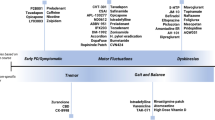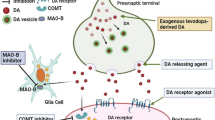Abstract
More therapeutic options have become available for Parkinson’s disease (PD) in recent years, leading to significant improvements in motor control both at early and advanced disease stages. More importantly, the need to expand disease management beyond motor symptom control has been recently highlighted and contribution of non-motor features to quality of life is now relevant. Dopamine agonists represent a valid therapeutic option in PD and their effect on non-motor domains like mood or cognition is now acknowledged as a key factor in fully addressing patients’ needs. Pramipexole is a well established dopamine agonist that is currently being investigated for its potential disease-modifying effect and action on mood in PD. In this review we will examine factors contributing to treatment decision-making and discuss how a proper balance between motor and non-motor features should be aimed for in approaching PD therapy.
Similar content being viewed by others
References
Quinn N, Critchley P, Marsden CD (1987) Young onset Parkinson’s disease. Mov Disord 2:73–91
Schrag A, Ben-Shlomo Y, Brown R et al (1998) Young onset Parkinson’s disease revisited — clinical features, natural history, and mortality. Mov Disord 13:885–894
Hristova AH (2000) Early Parkinson’s disease: what is the best approach to treatment? Drugs Aging 17:165–181
Grosset D, Taurah L, Burn DJ et al (2007) A multicentre longitudinal observational study of changes in self reported health status in people with Parkinson’s disease left untreated at diagnosis. J Neurol Neurosurg Psychiatry 78:465–469
Fahn S, Oakes D, Shoulson I et al (2004) Levodopa and the progression of Parkinson’s disease. N Engl J Med 351:2498–2508
Antonini A (2007) Continuous dopaminergic stimulation — From theory to clinical practice. Parkinsonism Relat Disord 13[Suppl]:S24–S28
Kondo T (2002) Initial therapy for Parkinson’s disease: levodopa vs. dopamine receptor agonists. J Neurol 249[Suppl 2]:II25–II29
Suchowersky O, Reich S, Perlmutter J et al (2006) Practice Parameter: diagnosis and prognosis of new onset Parkinson disease (an evidence-based review) of the American Academy of Neurolology. Neurology 66:968–975
Rinne UK, Bracco F, Chouza C et al (1998) Early treatment of Parkinson’s disease with cabergoline delays the onset of motor complications. Results of a double-blind levodopa controlled trial. The PKDS009 Study Group. Drugs 55[Suppl 1]:23–30
Rascol O, Brooks DJ, Korczyn AD et al (2000) A five year study of the incidence of dyskinesia in patients with early Parkinson’s disease who where treated with ropinirole or levodopa. 056 Study Group. N Engl J Med 342:1484–1491
The Parkinson Study Group (2002) Pramipexole vs Levodopa as initial treatment for Parkinson Disease. A randomized controlled study. JAMA 5:1653–1661
Antonini A, Poewe W (2007) Fibrotic heart-valve reactions to dopamine-agonist treatment in Parkinson’s disease. Lancet Neurol 6:826–829
Parkinson Study Group (2002) A controlled trial of rasagiline in early Parkinson disease: the TEMPO study. Arch Neurol 59:1937–1943
Chaudhuri RK, Healy D, Shapira HV et al (2006) Non-motor symptoms of Parkinson’s disease: diagnosis and management. Lancet Neurol 5:235–245
Antonini A, Colosimo C, Marconi R et al (2008) The PRIAMO study: background, methods and recruitment. Neurol Sci 29:61–65
Antonini A (2008) Unravelling depression in Parkinson’s disease. Eur J Neurol 15:885–886
Kulisevsky J, Pascual-Sedano B, Barbanoj M et al (2007) Acute effects of immediate and controlled-release levodopa on mood in Parkinson’s disease: a double-blind study. Mov Disord 22:62–67
Lemke MR, Brecht HM, Koester J, Reichmann H (2006) Effects of the dopamine agonist pramipexole on depression, anhedonia and motor functioning in Parkinson’s disease. J Neurol Sci 248:266–270
Barone P, Scarzella L, Marconi R et al and the Depression/Parkinson Italian Study Group (2006) Pramipexole versus sertraline in the treatment of depression in Parkinson’s disease: a national multicenter parallel-group randomized study. J Neurol 253:601–607
Author information
Authors and Affiliations
Corresponding author
Rights and permissions
About this article
Cite this article
Antonini, A., Barone, P. Dopamine agonist-based strategies in the treatment of Parkinson’s disease. Neurol Sci 29 (Suppl 5), 371–374 (2008). https://doi.org/10.1007/s10072-008-1049-4
Published:
Issue Date:
DOI: https://doi.org/10.1007/s10072-008-1049-4




